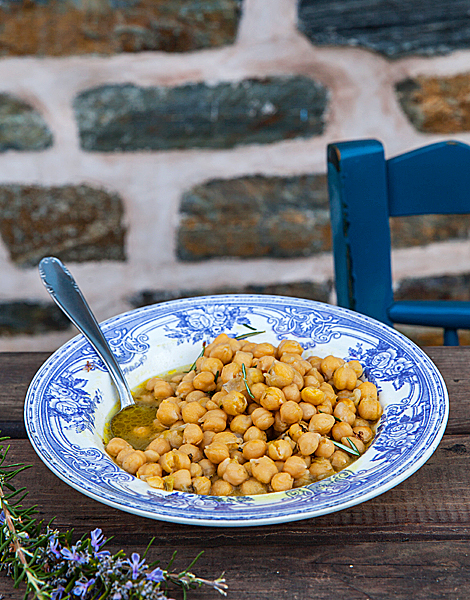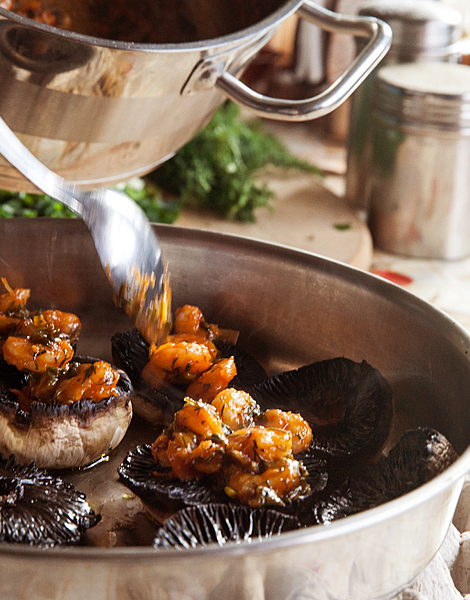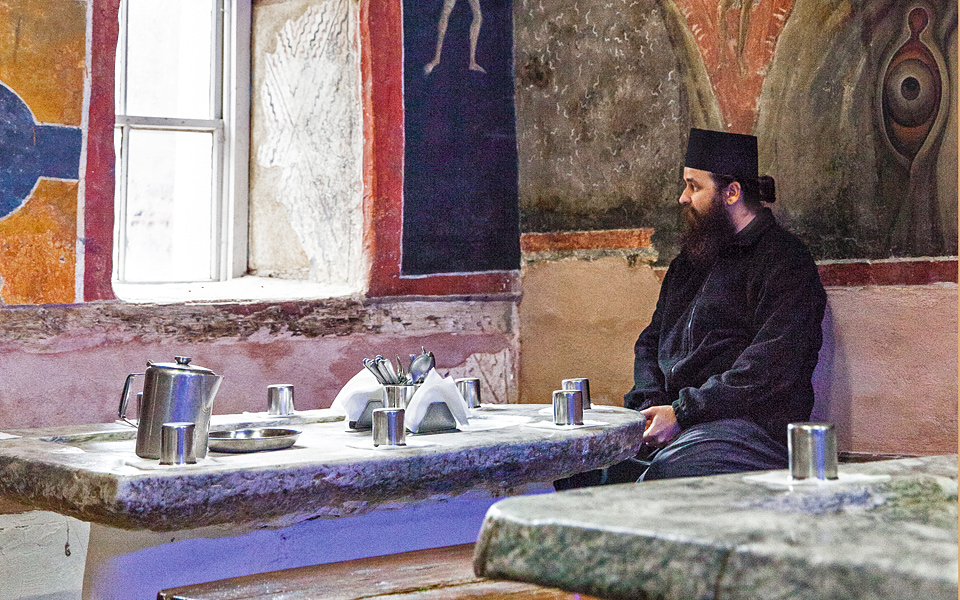On my first visit to the monastic community of Mount Athos, I am unprepared, unread and uninitiated – probably for the best. My boat sets off on its silent journey, gliding across the calm waters below emerald-green hills. There’s a certain weightlessness about this part of the world, as though it is suspended between sky and sea, like a floating island. Buildings peek out from among tall trees, some deserted, others still in use; monasteries and sketes (clusters of individual dwellings where monks live a less communal life), towers and docks, kellions and huts dating mostly from the Middle and Late Byzantine periods (a few from later than that). This is Mount Athos, an ark of history and a treasury of tradition and civilization, yet nothing like a museum. Life pulsates behind its sturdy walls and, for a few days, I will be privileged to witness it with the monks, participating in another vibrant tradition: monastic cooking.
At the harbor of Dafni, I am met by a cheerful buzz of monks, visitors, backpackers and laborers climbing in and out of SUVs sent by the monasteries to bring in pilgrims and supplies. Most visitors stop by Karyes, Mount Athos’ administrative center – it has a bank, a bakery and grocery stores, as well as shops selling handicrafts made by the monks. We pick up some bread and other supplies there and head to Mylopotamos, the Holy Seat of the Monastery of Aghios Efstathios, on the eastern side of the promontory.
My travel companion is Father Epiphanios, known to his friends as the head chef of Mount Athos. My soul leaps as we reach the kellion of Mylopotamos, built on a rock jutting out in the sea. The sky is white; a veil of fog covers the mountainside and the vineyard, all the way down to the water’s edge. Pilgrims wait to be blessed. A glass of water and a sip of tsipouro later, I am summoned by Epiphanios to follow him into the kitchen. He sets me to the task of slicing cabbage, carrots and onions. Beside me, people are chopping potatoes while olive oil simmers in a massive pan set over a wood fire. I feel the calm of communal life. Once we’ve eaten and cleaned up after a meal of rice, fried potatoes, cabbage salad, feta cheese and bread that sated 11 diners all told, we sit down in the kitchen to enjoy a cup of coffee and talk about the cuisine of this unique monastic community.
Epiphanios describes it as a melting pot of culinary knowledge and experiences. “When the monks come here, they bring their culture, their traditions and the flavors of their homelands,” he says. This, he explains, has resulted in the evolution of a multifaceted culinary tradition, shaped by local elements as well, that has produced a kind of cooking with its own distinctive character.
“Life pulsates behind its sturdy walls and, for a few days, I will be privileged to witness it with the monks, participating in another vibrant tradition: monastic cooking.”

© Dimitris Vlaikos
Diverse influences
Indeed, when you think about it, it is not often that you come across so many people with different backgrounds – such a concentration of disparate traditions – gathered together in a close-knit setting. Of course, like in every local cuisine, there is common ground, too, some convergent flavors and a repertory of ingredients, techniques and dishes that form the basis of the area’s unofficial recipe book. Red pepper, so popular all over northern Greece, is a staple in the dishes of Mount Athos, widely used, along with black pepper, to add sweetness, color and intensity. Cumin, so beloved in Asia Minor and the Middle East, seasons several of the vegetable and pulse stews here; in fact, Father Epiphanios even uses it in his fish soup. He explains that he acquired a taste for it while staying at the Monastery of Saint Catherine of Sinai in Egypt.
Father Georgios, a cook at the church school near Karyes, learned the art of canning from his mother back in Evros, on the border with Turkey and Bulgaria. Among many other things, he cans tomato sauces, eggplants, peppers, bean salads and salted fish. Father Nikitas, who hails from the eastern Aegean island of Kos, knows all about octopus, thanks to his father, a fisherman. Defying the old monkish habit of cooking the octopus in boiling water for several hours, he simmers it in its own juices instead.
All these influences don’t just get tossed in the pot. They are analyzed, discussed and tested, and only when they pass muster are they allowed onto the daily menu. When there are 50, 100 or even 1,000 mouths that need to be fed, as can be the case at large celebrations, the monastery chef faces the daunting task of trying to please everybody while making sure that his food is neither bland nor indifferent. This is undoubtedly why his is considered among the monastery’s most challenging duties.
“Red pepper, so popular all over northern Greece, is a staple in the dishes of Mount Athos, widely used, along with black pepper, to add sweetness, color and intensity.”

© Dimitris Vlaikos
Herbs & spices
The cardinal rule of monastic diet has also shaped this cuisine’s identity: monks in these communal monasteries are not allowed to eat meat. Fish is the “good” stuff, reserved for holidays and special feasts like Easter. The rest of the year, they subsist on vegetables, pulses, pasta, grains and other seafood.
“These limitations force you to become inventive,” says Father Epiphanios. “You need to learn how to cook octopus in many different ways so you don’t grow bored of it. And if you consider that, for around 200 days of the year, the monks do not even use olive oil in their food, you need to make the food on the rest of those days that much more delicious.”
To that end, the monks use a number of different herbs and spices to give their food more flavor, something that is not that common in Greek cuisine. “You won’t find a recipe on Mount Athos that doesn’t use fennel, parsley, mint, red pepper, cinnamon, allspice or cumin,” says Father Georgios.
Slow cooking is another must. “You have fast food, slow food and monk food,” says Father Epiphanios, only half-joking. “Good food needs time. The other day, I was watching a cooking show on television, and the presenter sautéed the onions for less than a minute. Onions need to be sautéed over time so they become sweet and golden, so they flavor the food and melt nicely.”
“The monks use a number of different herbs and spices to give their food more flavor, something that is not that common in Greek cuisine.”

© Dimitris Vlaikos

© Dimitris Vlaikos

© Dimitris Vlaikos
Homegrown groceries
All of the food I taste during my sojourn is extremely delicious. I’m certain this is largely due to the monks’ experience and skill, but there is another factor at play as well: “All of the monasteries grow their own vegetables; clean, pure vegetables,” says Epiphanios.
“If a monastery doesn’t have a garden, it’s crippled,” adds Father Georgios. “Because, in addition to the monks, there are also the pilgrims, so they have to have a selection of everything in order to cope with demand.”
I have noticed the vegetable gardens, big and small, that abut every monastery on my tours of the place. And it’s not just the monasteries that have them; every annex, skete and kellion has its own. The largest of these gardens is at Megiste (Great) Lavra; 8 hectares planted with vegetables and fruit trees, not to mention its large groves of olives (every monastery produces its own olive oil, made from local olive varieties)and its vineyards.
“The hostel here accommodates around 20,000 people a year. You can’t buy the food you need to feed them all,” says Father Avraam, as he shows us around the community’s oldest monastery. With him, we go to meet Artemios, the monastery’s elderly gardener, thanks to whom this impressive garden was created 27 years ago.
“When I was a younger man, I wrote to the Council of Elders and requested this hut here so I could do some gardening, and they said yes,” he says, showing me around the farm. “I planted a small garden with a few trees, and expected congratulations when the abbot, Philippos, came to see it. That didn’t work out as I imagined. ‘This is nothing,’ he said to me. I was devastated. ‘This is a mere eccentricity. You must do something for all the fathers. Then it will be blessed,’ he told me.”
“The monks will buy food when necessary, but the majority of the fruits and vegetables consumed at the monastery grow in the fields supervised by Father Artemios. ”

© Dimitris Vlaikos

© Dimitris Vlaikos

© Dimitris Vlaikos
Artemios scraped together some money by performing blessings and by selling a small plot of his father’s. He wrote another letter asking permission to plant more trees and vegetables. “I brought in a bulldozer and some hands to help out. With help from some of the older monks and from professional agronomists, we succeeded, with some ups and downs, of course. God be praised. All of these people, the monks and the laborers, we all eat thanks to this garden.”
The monks will buy food when necessary, but the majority of the fruits and vegetables consumed at the monastery grow in the fields supervised by Father Artemios. He shows me a field covered in plastic sheeting: “Here we’ve planted seeds: leeks, celery, celery root and chard. We’ve put the plastic to keep them warm so they can shoot, and then we’ll transplant them.”
In the summer, he grows peppers for frying and stuffing, as well as eggplants, beans and masses of tomatoes, rows and rows of them; the tomatoes grow through early December. He shows us his apple, cherry and peach trees. Then we head over to the nurseries and into a huge hothouse made from the trunks of chestnuts and heated with wood-burning stoves.
“We built this to grow bananas, but it was a hassle. They needed heat from October and it was very tiring for the workers who had to chop wood every three hours,” says Artemios. “We don’t have the climate for that kind of thing, so now we grow tomatoes here.”
Bounty of nature
At Panaghia Portaitissa, a kellion of the Koutloumousiou Monastery, Father Nikitas makes an original and fragrant version of taramosalata (fish roe paste) using an old recipe. “The old fathers were very knowledgeable,” he says, and he’s not just referring to recipes, but also to their use of the wild bounty of nature. “We gather all sorts of greens and herbs, such as oregano, dandelion and St John’s wort to make oil in the summer. In the fall, the place is full of wild mushrooms, which we pickle to have something to offer guests as a snack. We also pickle eggplants, cabbage and sow-thistle roots. There is something all year round. We make sweets out of figs, chestnuts, walnuts and crab apples – the crab apples are a classic. Then there’s all the wild greens: chicory, horse parsley, wild carrot, white mustard, poppies, black bryony…. Food can be made so much better with these.”
“The sea that surrounds the Mount Athos peninsula supplies the monks with plentiful fresh fish and other seafood.”

© Dimitris Vlaikos

© Dimitris Vlaikos
Gifts of the sea
The sea that surrounds the Mount Athos peninsula supplies the monks with plentiful fresh fish and other seafood. “We have lots of white sea bream, bluefish, striped bream, flathead grey mullet, sea bass, hake and such,” says Nikitas, who hails from a family of fishermen. “They bring mussels in over at Vatopedi and shrimp from Ephsigmenou and beyond,” he says, mentioning two monasteries on the northeastern coast. The sea here is also rich in octopus, calamari and squid, while the monks even make jellyfish cakes with spring onion, dill and breadcrumbs.
Both the father and grandfather of Father Akakios were fishermen. We meet him in the morning on the dock of Mylopotamos as he returns with the nets he cast the previous night. He begins to unload what he landed and starts sorting his catch. He talks to us about the depletion of fish stocks and the challenges of coastal fishing.
“The sea needs proper maintenance at the right time,” he explains. “Fish need to be given a certain amount of time to grow. What will be left if they’re caught small? Nothing. We can talk and talk, but the sea needs to be protected. Not like now. They allow the trawlers to fish all year round. Hake give birth in April and the trawlers are out until late May. Coastal fishermen are not allowed to catch hake, but trawlers are. We’re heading for disaster.”
It’s entirely possible he’s right, but at this moment, in this magical place, with the tastes of tradition and innovation still lingering on my palate, I can’t help but feel hopeful.











